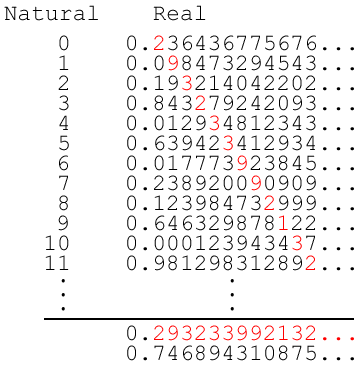You are using an out of date browser. It may not display this or other websites correctly.
You should upgrade or use an alternative browser.
You should upgrade or use an alternative browser.
Science and Technology Quiz 3
- Thread starter Aramazd
- Start date
- Status
- Not open for further replies.
SS-18 ICBM
Oscillator
Show me how there can be a one-to-one correspondence between the set of natural numbers and the set of integers.
ParadigmShifter
Random Nonsense Generator
Assuming 0 isn't a natural number 
1->0
2->1
3->-1
4->2
5->-2
so n maps to:
0, if n = 1
n/2 if n is even
-(n-1)/2 is n is odd and > 1
similarly if you count 0 as a natural number.
EDIT: And vice versa of course to get a bijection.

1->0
2->1
3->-1
4->2
5->-2
so n maps to:
0, if n = 1
n/2 if n is even
-(n-1)/2 is n is odd and > 1
similarly if you count 0 as a natural number.
EDIT: And vice versa of course to get a bijection.
GoodGame
Red, White, & Blue, baby!
- Joined
- Dec 17, 2004
- Messages
- 13,725
Show me how there can be a one-to-one correspondence between the set of natural numbers and the set of integers.
If you take the absolute value of all members of the set of integers, you'll duplicate the set of natural numbers (except there will only be one "zero").
SS-18 ICBM
Oscillator
That was too easy, wasn't it?  Your turn, ParadigmShifter.
Your turn, ParadigmShifter.
 Your turn, ParadigmShifter.
Your turn, ParadigmShifter.ParadigmShifter
Random Nonsense Generator
You mean me I presume, I'll think of one and post it tomorrow. In the meantime you can show how the rational numbers also have a 1:1 correspondence with the naturals 
EDIT: GoodGame only gave a 1 way mapping

EDIT: GoodGame only gave a 1 way mapping

SS-18 ICBM
Oscillator
Just draw a grid with all the natural numbers on the horizontal axis and vertical axis, and for each cell in the grid divide the natural numbers on the axes. Draw diagonal lines showing the progression of the numbers (going through all the way to infinity), and put them in a one-to-one correspondence with the natural numbers, including the negative rationals. 

Naturals/Rationals: 0/0 1/1 2/-1 3/-1 4/-1 5/2 6/-2 7/(1/2) 8/(-1/2) ...


Naturals/Rationals: 0/0 1/1 2/-1 3/-1 4/-1 5/2 6/-2 7/(1/2) 8/(-1/2) ...
ParadigmShifter
Random Nonsense Generator
Yeah that's right but it isn't my proper question, more an expansion of yours  I'll ask mine tomorrow.
I'll ask mine tomorrow.
Can you go for the encore and show why real numbers can't be put into a similar correspondence? (You can use just the interval [0,1] if you want).
 I'll ask mine tomorrow.
I'll ask mine tomorrow.Can you go for the encore and show why real numbers can't be put into a similar correspondence? (You can use just the interval [0,1] if you want).
SS-18 ICBM
Oscillator
Can you go for the encore and show why real numbers can't be put into a similar correspondence? (You can use just the interval [0,1] if you want).
Well, that's not I know how to explain it. Just come up with a list of every single real number paired with the natural numbers, and you can come up with one that isn't present in it.

If the number was the same as any one number in the list, then the one digit of it won't be different from the digit of the number in the list. There is one number that isn't in any correspondence with any natural number.
ParadigmShifter
Random Nonsense Generator
Mise
isle of lucy
Guys, don't make me tag this thread as 'gay' 



ParadigmShifter
Random Nonsense Generator
I'll do a short Q about computing, this will probably be easy if you google it so that is discouraged 
Byte ordering of data on a computer depends on the endianness mode of the processor (big endian or little endian).
So where did the name come from originally?

Byte ordering of data on a computer depends on the endianness mode of the processor (big endian or little endian).
So where did the name come from originally?
SS-18 ICBM
Oscillator
Guys, don't make me tag this thread as 'gay'

I don't get it.
I'm going to guess that it comes from the letters N and D (big endian), n and d (little endian).
But I have no guess as to why.
But I have no guess as to why.

ParadigmShifter
Random Nonsense Generator
All wrong answers so far 

GoodGame
Red, White, & Blue, baby!
- Joined
- Dec 17, 2004
- Messages
- 13,725
I'm going to guess that it comes from the letters N and D (big endian), n and d (little endian).
But I have no guess as to why.
That has me thinking about logic gates (like aND). Maybe going to assembly language programming it's like the bit of an instruction byte that applies some feature of a logic gate instruction. I'd have to search the attic for my Intel x86 assembly reference book to answer (which I won't
 ) .
) .ParadigmShifter
Random Nonsense Generator
I'm not sure the assembly language book will have the origins of the word endian in it 
Wikipedia is definitely off limits though

Wikipedia is definitely off limits though

ParadigmShifter
Random Nonsense Generator
Nah the answer is well... different to say the least 

- Status
- Not open for further replies.
Similar threads
- Replies
- 0
- Views
- 215
- Replies
- 0
- Views
- 318
- Replies
- 3
- Views
- 839
- Replies
- 12
- Views
- 1K

 Open Floor
Open Floor